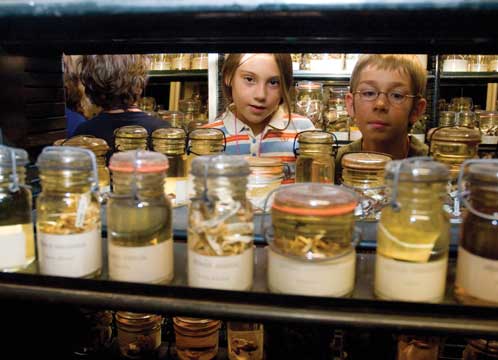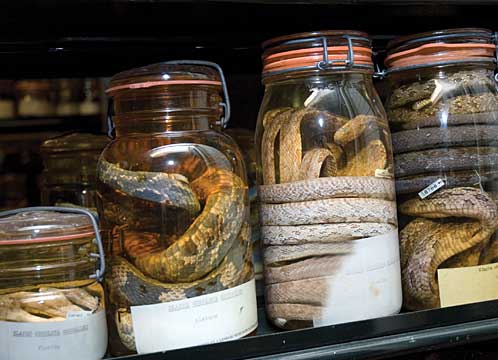 Fall 2008
Fall 2008|
The Herp House
It’s creepy and kind of gross. And for kids who get a shot at touring the fabled home of Carnegie Museums’ herpetology collection, what could be better? During a recent day at summer camp, Emily and a group of other 8- and 9-year-olds toured a section of the Museum of Natural History rarely seen by the public. Tucked away in the bowels of the Oakland museum is the Alcohol House, home of its herpetology collection. Think animals that crawl or slither; or in this case, did at one time.  Campers get up close and personal with the herp collection.“Some of the Boy Scouts would stay in there all night if we’d let them,” says Camp Earth and children’s classes coordinator Angie Stokes, who, in an average year, leads hundreds of campers, scouts, and overnight visitors through the “Herps House”—which she, too, distinguishes as “one of the coolest tours at the museum.” It’s called the Alcohol House because the herps (scientific slang for amphibians and reptiles) are preserved in jars filled with 70 percent ethanol. And it’s quite a sight: endless rows of jar after jar after jar stacked to the brim with salamanders, snakes, frogs, and lizards of all kinds, and even a few thousand fluid-preserved birds. In reality, there are 18,000 Mason-style and French canning jars, ranging in size from eight ounces to five gallons, showcasing 210,000 specimens, some dating as far back as the 1860s. And that’s not to forget the 140 tanks of turtles, one of which houses the head of a giant leatherback—which, during Emily’s tour, received almost as many squeals and cheers as the enormous anaconda head.  Set loose in pairs, kids fan out on a hunt for the creepiest find, a hairy frog here, a slimy two-foot-long hellbender there. Two boys immediately come face-to-face with a serious stash of geckos, numbering in the hundreds and so diverse they represent a kind of United Nations of herpetology. The boys race to shout out the country names printed on the jars: Antigua, Mexico, the Netherlands, Trinidad, Venezuela, Morocco, the Virgin Islands, Tunisia, Namibia, Madagascar, South Africa, Angola, Tanzania. And diversity is exactly the point, Stokes explains. “Do we all look alike? Did we all have the same breakfast this morning?” she asks the campers. “Of course not. So if we were to collect and study people, we’d need to collect people of all ages, of all heights and weights, and from places around the world. We’d even want to know what each ate for breakfast. It’s the same for these herps.” Stephen Rogers, the collection’s longtime caretaker, describes the collection as “reasonably diverse” and, rather than specializing, it includes “a little of everything,” including herps from nearly every country in the world (even some that no longer exist) and all 50 states. But it definitely has its standouts: one of the largest Indian collections outside of India, the largest Spanish collection in a U.S. museum, a strong Pennsylvanian collection reflecting 110 years of ‘herping’ in the Northern Appalachians, and a giant assortment of turtles (about 27,500). C.J. McCoy, curator of the section from 1964 to 1993, once wrote that a major collection of herps “is like a three-way hybrid between a pickle warehouse, a reference library, and a mail-order establishment.” A peek in the collection’s logbook reveals that its mail-order business has reached well beyond state borders, with specimens currently on loan to the Smithsonian, University of Texas at Austin, University of Ohio, University of California, Berkeley, and researchers in Virginia, Connecticut, Oregon, and Paris, France. And because the collection ranks in the top 10 in the United States, researchers also trek to Pittsburgh to study it. For example, scientists doing research for a book about the reptiles of Tennessee spent days pouring over all specimens that hailed from the Volunteer State—all 1,100 of them. “No one collection has it all,” says Rogers, who pulls double duty as the collection manager of the section of birds. “You jointly go around the world investigating science. Preserved over decades, these specimens tell us what once was, and provide clues about why and how the natural world has changed. It’s not always by man.” Collections, notes Rogers, are built largely by the friends you keep. And the interests of past resident curators and other museum staff have definitely made an impact here. The Indian collection was built, for instance, by a research associate who did serious, long-term field work in that part of the world. Museum of Natural History curators helped researchers in Paraguay start the country’s first collection and, in turn, brought back valuable specimens collected during their travels. The museum also accepts orphaned (donated) collections and has purchased specimens from places such as Bolivia and Brazil. In its 113-year history, the section included at least one, sometimes two curators. But in 2003, the then-solo curator left for another museum and was not replaced. But last year, the museum received a gift from the Heinz Endowments, in honor of the late Bill and Ingrid Rea, to endow a curator. “I’m very excited about refilling the curator position,” says Rogers, standing in an aisle surrounded by jars of snakes. “This place is a wonderful visual for the kids, especially come Halloween, but each and every specimen here has something valuable to offer. This is a serious research collection.” |
Also in this issue:
Dream Machine · Burb Appeal · Transformers · Speaking Their Language · President's Note · NewsWorthy · Now Showing · Face Time: Andy Mack · Artistic License: In the Name of Hybrid Theater · About Town: A Road Map to Scientific Treasure · Another Look: The Child Mummy
 |
Copyright © 2017 CARNEGIE Magazine. All rights reserved. |
